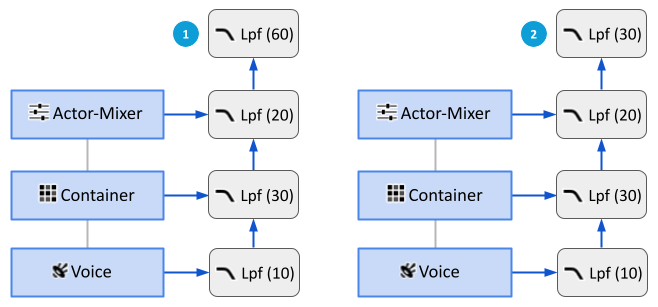Understanding property filter behavior (LPF, HPF)
The cumulative behavior of filter properties, such as Low-pass filter and High-pass
filter, can be set to one of two possible methods:
The filter behavior is defined for the entire project, and applies to the properties listed below.
Low-pass filter.
High-pass filter.
Output Bus Low-pass filter.
Output Bus High-pass filter.
User-defined Auxiliary LPF 0.
User-defined Auxiliary LPF 1.
User-defined Auxiliary LPF 2.
User-defined Auxiliary LPF 3.
Game-defined Auxiliary Sends LPF.
User-defined Auxiliary HPF 0.
User-defined Auxiliary HPF 1.
User-defined Auxiliary HPF 2.
User-defined Auxiliary HPF 3.
Game-defined Auxiliary Sends HPF.
To configure your project's filter behavior, refer to Configuring filter behavior.
The illustration below demonstrates how the property values are accumulated within the project hierarchy.
Configuring filter behavior
The filter behavior is specified via the Project Settings.
![[Caution]](/images/2023.1.3_8471/?source=Help&id=caution.png) | Caution |
|---|
When changing the filter behavior, Wwise will: Modify Work Units to adjust RTPC curves and State values for filter properties. Save, close, then reload the Project.
The changes to the Work Units cannot be undone. Ensure that you have a saved copy of your project before changing the filter behavior, should you wish to revert later on. |
To configure the filter behavior:
Open the Project Settings dialog by doing one of the following:
Switch to the General tab.
In the Filter Behavior group, select the desired filter behavior:
Click OK to apply the settings.
Tell us about your project. We're here to help.
Register your project and we'll help you get started with no strings attached!
Get started with Wwise



![[Caution]](/images/2023.1.3_8471/?source=Help&id=caution.png)